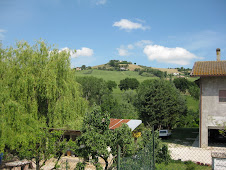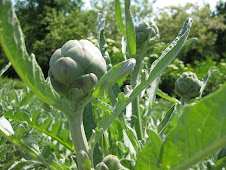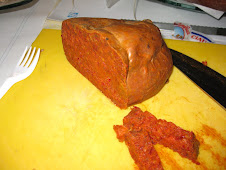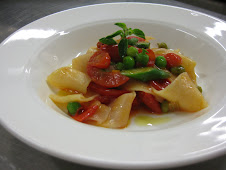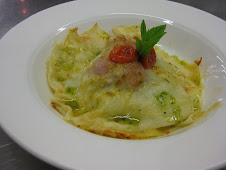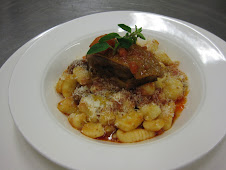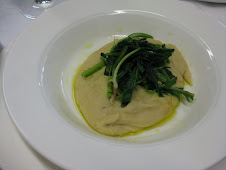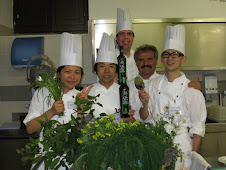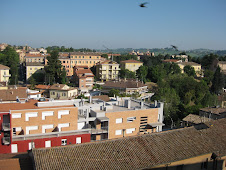“When the moon hits your eye” – oh wait a minute we did not even discuss pizza pie in our studies of the region of Campania. In fact the cuisine that we prepared representing the region of Campania was quite different than what I had imagined we would be preparing. Baccala’ alla Napoletana and Parmigiana Melanzane perhaps, but Baba alla Crema, and Paccheri alla Genovese huh? Putting my ignorance and preconceived notions aside and embracing the culinary offerings of Chef Antonio Tubelli proved to be a fun, tasty and enlightening experience. The cuisine of the region is infused with international influences and offers gustatory pleasures far beyond Pizza, Mozzarella di Bufala, and San Marzano tomatoes, all of which I consume liberally with glee.
It was interesting that the chef used the word contamination to describe the influences of other cultures. From my American point of view I took the use of the word contamination as a negative, and asked the chef if he meant that the cuisine had been “polluted”. He said that he was not using the word in a negative context, but to describe the influences of centuries of contact with peoples and cultures of a diverse nature. The city of Naples was founded by the Greeks and means “new city”. Naples was located on the Via Appia and connected Rome to Brindisi and across the Adriatic, and Ionian Seas to Greece. Following the years of Roman rule Naples came under Arab, Norman, Swabian, French, Spanish, and Austrian rule all influencing the culture, food, and eating habits of the region. For centuries Naples was the most important city in the Kingdom of the Two Sicily’s, which included all of southern Italy and Sicily. The chef stressed that at one point in history there were two main world cuisines French and the cuisine of the Kingdom of the Two Sicily’s. The chef’s discussion of the final stages of the unification of Italy was interesting. In his eyes we were not discussing the unification of the country, but the conquering of the south by the north. The cuisine of the south as it was prior to 1860 was destroyed in his eyes. Surprisingly although introduced much earlier it wasn’t until the first half of the 18th century that tomatoes and potatoes would become staples in the daily diet of the people of Campania.
Traditionally the lower classes of the region ate primarily the fruits and vegetables of the land and thus were known as “leaf eaters”, later when the consumption of pasta became commonplace this same class of people came to be known as “pasta eaters”. An interesting tidbit about a dish you will find in both Campania and Sicily called Caponata. In Sicily Caponata is a vegetable dish based on eggplant, but in Campania the dish is based on dry bread. In Campania it is a fishermen’s dish in which traditionally the dry bread would be dipped into sea water, broken up, and mixed with tomatoes, and if available fish.
Thursday, July 24, 2008
Thursday, July 17, 2008
Abruzzo
Rugged, tough, and intense can be used to not only describe the region of Abruzzo, but also hints at the personality of our chef Peppino Tinari for the study and preparation of the cuisine of Abruzzo. The region of Abruzzo is considered by many to be Italy’s last great wilderness. Peppino said that two thirds of the region is national park land and is Italy’s greenest region. The region is sparsely populated, and is dramatic with the Apennine Mountains cutting through it making it necessary for many towns and farms to be in locations with drastic vertical slopes. Driving through Abruzzo on the A24 you will traverse the Gran Sasso and in mid June you will find plenty of snow on its peaks. The Gran Sasso is the highest peak in the Apennine range and is the highest point on the Italian mainland south of the Alps. If you remember last week’s comments regarding Umbria you are probably thinking that Abruzzo must have a coastline, and therefore seafood. You are correct and the coastal cuisine is similar to other regions along the Adriatic with various rich hearty Brodetto’s (fish stews) being found up and down the coast. Peppino did not talk a lot during our two days of cooking the cuisine of his homeland, but he did say that he had a passion for the products he used, he did not like modern technology in the kitchen, and he preferred the ancient traditional ways of cooking.
Probably the most famous dish of this region and one of the most famous pastas in the world is Chitarrina. The pasta is cut with a special tool, the chitarra, or guitar. The instrument is a rectangular box strung with strings and resembles a small guitar. You roll out your pasta dough usually made with egg yolks to about 1/8-1/4 inch thick, lay the dough over the strings and use a rolling pin to press the dough through the strings to obtain square-cut spaghetti like pasta noodles. The pasta is usually served with a meat ragu, but can also be served with simple, seasonal vegetables like tomatoes and fresh herbs. Farro or spelt wheat is grown and used extensively in the region. Farro can be used as featured item in soups, but also ground to make flour to use in pastas, which is common in this region, read, and coarse ground to make polenta.
Lamb is the primary meat raised and utilized in the region, and therefore you will find sheep milks cheeses in the region. The chef brought in a whole lamb for our class which we promptly dismantled, and we cooked about 10 different lamb dishes over the two days, utilizing every part of the lamb including all internal organs, and splitting and roasting its head. As in other regions rabbit and pork play an important part in the cooking of Abruzzo. Pig as in the rest of Italy is particularly important for its ability to not only be eaten fresh, but more critically its ability to be made into salume, and to be eaten all year.
Almonds grow plentifully in the Abruzzo and are featured in many desserts, and breads. The region produces excellent Olive Oil and wines. In fact some call the region the ”land of olive groves”. Red and white wines are produced in the region with one of the wines Colline Teramane holding the highest DOCG status. The most known wine of the area is the red Montepulicano d’ Abruzzo which holds DOC status. The region has recognized the importance of developing and promoting the quality products it has to offer such as wines, olive oils, cured meats, pasta, and truffles. It can be said that the cuisine of the region has been shaped by its environmental and economic history, that it is rooted in tradition, but embraces the opportunities of the future.
Probably the most famous dish of this region and one of the most famous pastas in the world is Chitarrina. The pasta is cut with a special tool, the chitarra, or guitar. The instrument is a rectangular box strung with strings and resembles a small guitar. You roll out your pasta dough usually made with egg yolks to about 1/8-1/4 inch thick, lay the dough over the strings and use a rolling pin to press the dough through the strings to obtain square-cut spaghetti like pasta noodles. The pasta is usually served with a meat ragu, but can also be served with simple, seasonal vegetables like tomatoes and fresh herbs. Farro or spelt wheat is grown and used extensively in the region. Farro can be used as featured item in soups, but also ground to make flour to use in pastas, which is common in this region, read, and coarse ground to make polenta.
Lamb is the primary meat raised and utilized in the region, and therefore you will find sheep milks cheeses in the region. The chef brought in a whole lamb for our class which we promptly dismantled, and we cooked about 10 different lamb dishes over the two days, utilizing every part of the lamb including all internal organs, and splitting and roasting its head. As in other regions rabbit and pork play an important part in the cooking of Abruzzo. Pig as in the rest of Italy is particularly important for its ability to not only be eaten fresh, but more critically its ability to be made into salume, and to be eaten all year.
Almonds grow plentifully in the Abruzzo and are featured in many desserts, and breads. The region produces excellent Olive Oil and wines. In fact some call the region the ”land of olive groves”. Red and white wines are produced in the region with one of the wines Colline Teramane holding the highest DOCG status. The most known wine of the area is the red Montepulicano d’ Abruzzo which holds DOC status. The region has recognized the importance of developing and promoting the quality products it has to offer such as wines, olive oils, cured meats, pasta, and truffles. It can be said that the cuisine of the region has been shaped by its environmental and economic history, that it is rooted in tradition, but embraces the opportunities of the future.
Sunday, July 13, 2008
Umbria the Heart of Italy
For Umbria we had a great, energenic, young named Enea Barbanera. We had a lot fun cooking classic recipes of the region. If you can picture rolling hills dotted with olive trees and vineyards, fields filled with bright yellow sunflowers, and medieval villages perched high on the hill tops it will help set the mood for this week’s region, Umbria. Big, bold, and beautiful is how I would describe the cooking of one of Italy’s smallest regions. Umbria is located in central Italy and is one of the few regions in Italy to be land locked; the other land locked regions are in the northern most part of the country bordering France, Switzerland and Austria. Some say that Umbria has resisted globalization more so than other regions of Italy, and that it continues to strongly cling to its traditions, family traditions, recipes, and artisan food products. I first learned of Slow Food from Chef Lorenzo Polegri in the town of Orvieto, in Umbria 10 years ago. The Slow Food philosophy is thriving in Umbria and you will find many traditional places where local products are the foundation of the typical dishes of each area.
Umbria like the other regions of Italy has its share of duality in the history of its cuisine with dishes both from the noble courts and upper classes, as well as the peasant customs. The Etruscans and Romans both ruled Umbria at one time, and play a part in its cuisine, what we do not find in Umbria is the influence from the Arab or eastern world. Of course the surrounding regions of Tuscany, Lazio, the Marche, and Emilia-Romagna influence the cuisine in Umbria, but the cuisine here is still primarily based on the meats, game, vegetables, pecorino cheeses, and truffles of the area. The land in Umbria is very fertile and Apennine Mountains help to create many micro-climates in the region. Sagrantino di Montefalco a world class red wine is the product of one these micro-climates. Umbria also produces the famous white wine Ovrieto Classico in the hills surrounding the town of Orvieto. The olive tree is another beneficiary of the climate in the region, to some Umbria is known as the “land of olive oil” because of the quality and quantity of the oil produced in the region. Legumes are plentiful, as well as farro, wheat, potatoes, onions, celery, peas, mushrooms, and saffron. Truffles are found in the summer, fall, and winter.
Umbria is certainly known and respected for the quality of its cured meats. The town of Norcia in the southeast part of the region is best known for its artisan salumi and pork products, thus the term Norcino in Italian has come to denote an artisan craftsman in the field of salumi and pork processing. The typical products such as capocollo, prosciutto, guanciale, coppa, pancetta, mortadella, coralline and many others are produced in artisan shops throughout the region. The one pork product that you must try if you visit Umbria is Porchetta. Other regions make it also, but it is a masterpiece in Umbria. A whole pig stuffed with wild fennel, rosemary, garlic, and salt and pepper and roasted until it is crispy on the outside, juicy, tender, aromatic, rich, and tasty on the inside! Go to a piazza on market day, and find the Porchetta truck, all they have is one pig, get a slice, on a simple crusty piece of bread and munch it down, the perfect breakfast. Go early, but not too early because you don’t want the first couple of slices, let them get down into the loin a little, heaven! We cooked:
Panzanella, Penchi della Valnerina (cool folded pasta), Minestra di Pasta e Fagioli della Battitura, Torta al Testo con Coratella d' Agnello, Zuppetta di Fagioli Cannellini con Sformatino Fegatini e Buccia d' Arancia Carmellata, Coniglio in Porchetta, Zuppa di Farro Spezzato con Verdure e Pecorino, Stracciata con Cipolla Rossa, Orzo Mantecato con Faraona in Salmi', Bandiera, Gnocchi al Sugo d' Oca, Ravioli di Pecorino Fresco alla Crema di Peperone, Angello Farcito con Battuto e Patate Arrosto, Schiacciata con Salvia e Cipolla Rossa, Tagliatelle al Ragu d' Agnello, Zuppa di Lenticchie di Castelluccio di Norcia, Strangozzi all Spoletina, Filetto di Maialino al Latte con Salas di Pecorinio e Pera Cotta nel Vino, Baccala' con Uvetta e Prugne, Tegamaccio del Trasimeno.
Umbria like the other regions of Italy has its share of duality in the history of its cuisine with dishes both from the noble courts and upper classes, as well as the peasant customs. The Etruscans and Romans both ruled Umbria at one time, and play a part in its cuisine, what we do not find in Umbria is the influence from the Arab or eastern world. Of course the surrounding regions of Tuscany, Lazio, the Marche, and Emilia-Romagna influence the cuisine in Umbria, but the cuisine here is still primarily based on the meats, game, vegetables, pecorino cheeses, and truffles of the area. The land in Umbria is very fertile and Apennine Mountains help to create many micro-climates in the region. Sagrantino di Montefalco a world class red wine is the product of one these micro-climates. Umbria also produces the famous white wine Ovrieto Classico in the hills surrounding the town of Orvieto. The olive tree is another beneficiary of the climate in the region, to some Umbria is known as the “land of olive oil” because of the quality and quantity of the oil produced in the region. Legumes are plentiful, as well as farro, wheat, potatoes, onions, celery, peas, mushrooms, and saffron. Truffles are found in the summer, fall, and winter.
Umbria is certainly known and respected for the quality of its cured meats. The town of Norcia in the southeast part of the region is best known for its artisan salumi and pork products, thus the term Norcino in Italian has come to denote an artisan craftsman in the field of salumi and pork processing. The typical products such as capocollo, prosciutto, guanciale, coppa, pancetta, mortadella, coralline and many others are produced in artisan shops throughout the region. The one pork product that you must try if you visit Umbria is Porchetta. Other regions make it also, but it is a masterpiece in Umbria. A whole pig stuffed with wild fennel, rosemary, garlic, and salt and pepper and roasted until it is crispy on the outside, juicy, tender, aromatic, rich, and tasty on the inside! Go to a piazza on market day, and find the Porchetta truck, all they have is one pig, get a slice, on a simple crusty piece of bread and munch it down, the perfect breakfast. Go early, but not too early because you don’t want the first couple of slices, let them get down into the loin a little, heaven! We cooked:
Panzanella, Penchi della Valnerina (cool folded pasta), Minestra di Pasta e Fagioli della Battitura, Torta al Testo con Coratella d' Agnello, Zuppetta di Fagioli Cannellini con Sformatino Fegatini e Buccia d' Arancia Carmellata, Coniglio in Porchetta, Zuppa di Farro Spezzato con Verdure e Pecorino, Stracciata con Cipolla Rossa, Orzo Mantecato con Faraona in Salmi', Bandiera, Gnocchi al Sugo d' Oca, Ravioli di Pecorino Fresco alla Crema di Peperone, Angello Farcito con Battuto e Patate Arrosto, Schiacciata con Salvia e Cipolla Rossa, Tagliatelle al Ragu d' Agnello, Zuppa di Lenticchie di Castelluccio di Norcia, Strangozzi all Spoletina, Filetto di Maialino al Latte con Salas di Pecorinio e Pera Cotta nel Vino, Baccala' con Uvetta e Prugne, Tegamaccio del Trasimeno.
Friday, July 4, 2008
Sicilia Bella
The doors of the kitchen were flung open wide revealing beautiful golden rolling hills, small farms, and blue skies as the Chef gestured grandly with his arms and exclaimed “Sicilia Bella”. Whenever I hear or read of Sicily this scene immediately comes to mind. The image was branded on my brain almost 10 years ago when I was visiting Sicily and cooking in the kitchen of an agriturismo with the chef, Lino when he made this proclamation. Lino was not exaggerating as Sicily is a diverse beautiful region with the sea and the mountains less than 50 miles from each other on many parts of the island. The cuisine of the Veneto is probably the only other cuisine in Italy that can rival the complexity, and diversity of the cuisine in Sicily. Our chef/instructor for Sicily Damiano Ferraro said “that Sicily has 1000 years of fusion cuisine”. The Greeks, Romans, Arabs, and Spanish have all played significant parts in the development of the cuisine of the region. Because of its central position in the Mediterranean sea Sicily has been of strategic importance for over 2000 years.
Recipes have been found in Sicily which date back to the 4th century B.C. when Sicily was part of Greater Greece. Like many places as the cuisine developed two styles of cooking evolved, one for the wealthy and noble, and one for the lower classes. The wealthy brought chefs from France who reworked traditional foods into new, modern, and more elaborate preparations of fish, meats, fruits, and vegetables. Within the lower classes it was common to find focaccia, dried figs, olives, and salted fish. A few centuries later during Roman times wheat was introduced from Egypt and bread became a staple for the people.
Damiano stressed that the period of Arab rule was particularly important from a culinary standpoint for Sicily. There is a long list of food products that were introduced by the Arabs which include almonds, pistachios, raisins, asparagus, peaches, apricots, artichokes, various spices, oranges, lemons, and rice. In fact Sicily was the first region in Italy to grow rice. Agro-dolce dishes are a product of this era as well as the famous dessert Cassata alla Siciliana. Dishes that are prepared agro-dolce are sweet and sour and evolved as a food preservation technique. Today agro-dolce dishes are prepared because they taste delicious. The Spanish ruled Sicily after the discovery of America and contributed cocoa, sweet peppers, tomatoes, potatoes, eggplant, squash and turkey to the kitchen. By this time Sicily was well on its way to becoming a culinary powerhouse.
Obviously seafood is very important to the diet of people on the island, Tuna, bottarga (tuna roe), and pesce spada (swordfish) playing major roles. Olive trees grow readily everywhere on the island and have been cultivated for oil for centuries. Sicily is becoming known for its wines both red and whites. The indigenous grape Nero d’ Avola is used to produce quality red wines, but international grape varieties like Cabernet, Merlot and Chardonnay are also grown with great success. Sicily is also known for producing high quality Marsala and dessert wines such as Passiti di Pantelleria. I highly recommend a visit to Sicily not only for its natural beauty, but also to sample its gastronomic treasures.
Recipes have been found in Sicily which date back to the 4th century B.C. when Sicily was part of Greater Greece. Like many places as the cuisine developed two styles of cooking evolved, one for the wealthy and noble, and one for the lower classes. The wealthy brought chefs from France who reworked traditional foods into new, modern, and more elaborate preparations of fish, meats, fruits, and vegetables. Within the lower classes it was common to find focaccia, dried figs, olives, and salted fish. A few centuries later during Roman times wheat was introduced from Egypt and bread became a staple for the people.
Damiano stressed that the period of Arab rule was particularly important from a culinary standpoint for Sicily. There is a long list of food products that were introduced by the Arabs which include almonds, pistachios, raisins, asparagus, peaches, apricots, artichokes, various spices, oranges, lemons, and rice. In fact Sicily was the first region in Italy to grow rice. Agro-dolce dishes are a product of this era as well as the famous dessert Cassata alla Siciliana. Dishes that are prepared agro-dolce are sweet and sour and evolved as a food preservation technique. Today agro-dolce dishes are prepared because they taste delicious. The Spanish ruled Sicily after the discovery of America and contributed cocoa, sweet peppers, tomatoes, potatoes, eggplant, squash and turkey to the kitchen. By this time Sicily was well on its way to becoming a culinary powerhouse.
Obviously seafood is very important to the diet of people on the island, Tuna, bottarga (tuna roe), and pesce spada (swordfish) playing major roles. Olive trees grow readily everywhere on the island and have been cultivated for oil for centuries. Sicily is becoming known for its wines both red and whites. The indigenous grape Nero d’ Avola is used to produce quality red wines, but international grape varieties like Cabernet, Merlot and Chardonnay are also grown with great success. Sicily is also known for producing high quality Marsala and dessert wines such as Passiti di Pantelleria. I highly recommend a visit to Sicily not only for its natural beauty, but also to sample its gastronomic treasures.
Subscribe to:
Comments (Atom)











































































